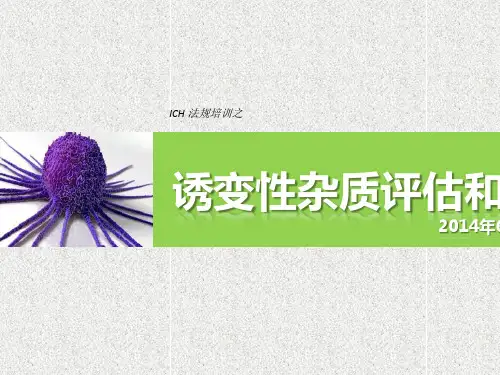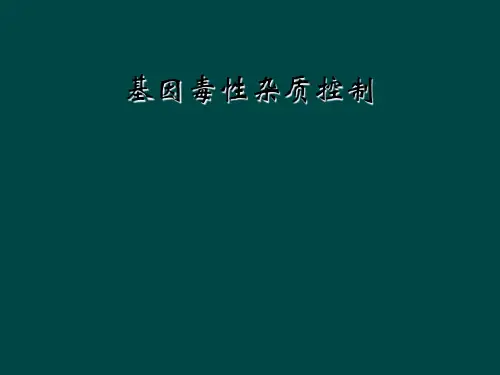(完整版)基因毒性杂质的评估与控制
- 格式:ppt
- 大小:15.85 MB
- 文档页数:45
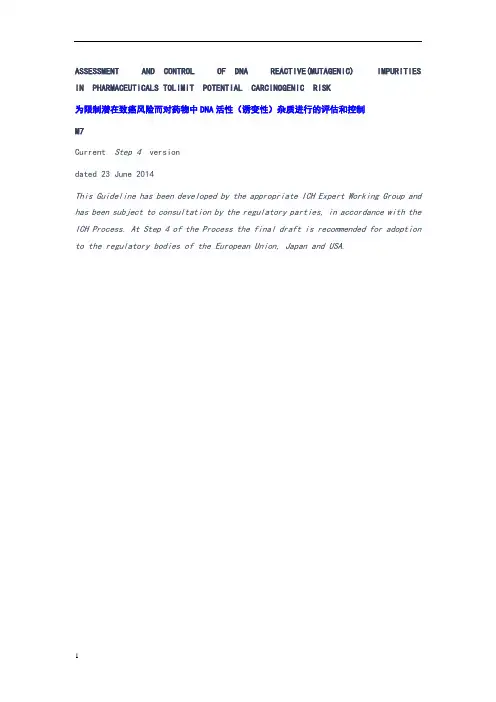
ASSESSMENT AND CONTROL OF DNA REACTIVE(MUTAGENIC) IMPURITIES IN PHARMACEUTICALS TOLIMIT POTENTIAL CARCINOGENIC RISK为限制潜在致癌风险而对药物中DNA活性(诱变性)杂质进行的评估和控制M7Current Step 4 versiondated 23 June 2014This Guideline has been developed by the appropriate ICH Expert Working Group and has been subject to consultation by the regulatory parties, in accordance with the ICH Process. At Step 4 of the Process the final draft is recommended for adoption to the regulatory bodies of the European Union, Japan and USA.M7Document History 文件历史Current Step 4 version 现行版本第4阶段Legal Notice: This document is protected by copyright and may be used, reproduced, incorporated into other works, adapted, modified, translated or distributed under a public license provided that ICH's copyright in the document is acknowledged at all times. In case of any adaption, modification or translation of the document, reasonable steps must be taken to clearly label, demarcate or otherwise identify that changes were made to or based on the original document. Any impression that the adaption, modification or translation of the original document is endorsed or sponsored by the ICH must be avoided.The document is provided "as is" without warranty of any kind. In no event shall the ICH or the authors of the original document be liable for any claim, damages or other liability arising from the use of the document.The above-mentioned permissions do not apply to content supplied by third parties. Therefore, for documents where the copyright vests in a third party, permission for reproduction must be obtained from this copyright holder.ASSESSMENT AND CONTROL OF DNA REACTIVE (MUTAGENIC) IMPURITIES IN PHARMACEUTICALS TO LIMIT POTENTIALCARCINOGENIC RISK为限制潜在致癌风险而对药物中DNA活性(诱变性)杂质进行的评估和控制ICH Harmonised Tripartite GuidelineICH三方协调指南Having reached Step 4 of the ICH Process at the ICH Steering Committee meeting on 5 June 2014, this Guideline is recommended for adoption to the three regulatory parties to ICHASSESSMENT AND CONTROL OF DNA REACTIVE (MUTAGENIC) IMPURITIES IN PHARMACEUTICALS TO LIMIT POTENTIALCARCINOGENIC RISK为限制潜在致癌风险而对药物中DNA活性(诱变性)杂质进行的评估和控制1. INTRODUCTION概述The synthesis of drug substances involves the use of reactive chemicals, reagents, solvents, catalysts, and other processing aids. As a result of chemical synthesis or subsequent degradation, impurities reside in all drug substances and associated drug products. While ICH Q3A(R2): Impurities in New Drug Substances and Q3B(R2): Impurities in New Drug Products (Ref. 1, 2) provides guidance for qualification and control for the majority of the impurities, limited guidance is provided for those impurities that are DNA reactive. The purpose of this guideline is to provide a practical framework that is applicable to the identification, categorization, qualification, and control of these mutagenic impurities to limit potential carcinogenic risk. This guideline is intended to complement ICH Q3A(R2), Q3B(R2) (Note 1), and ICH M3(R2): Nonclinical Safety Studies for the Conduct of Human Clinical Trials and Marketing Authorizations for Pharmaceuticals (Ref. 3).原料药合成牵涉到使用活性化学物质、试剂、溶剂、催化剂和其它工艺助剂,导致在所有原料药及其制剂中会残留有化学合成或其降解产物、杂质。
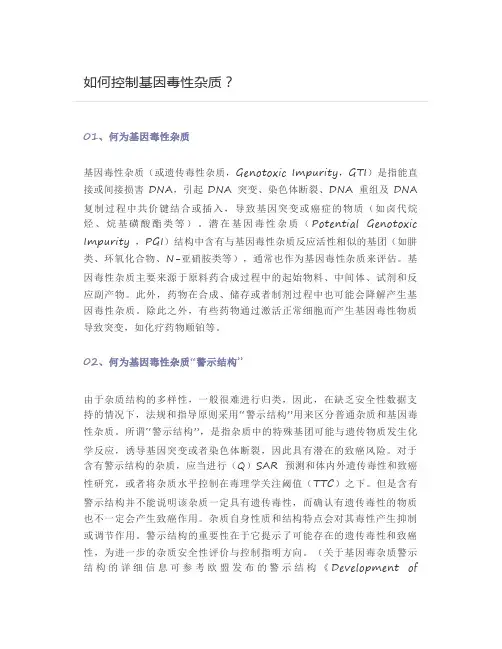
01、何为基因毒性杂质基因毒性杂质(或遗传毒性杂质,Genotoxic Impurity,GTI)是指能直接或间接损害DNA,引起DNA突变、染色体断裂、DNA重组及DNA 复制过程中共价键结合或插入,导致基因突变或癌症的物质(如卤代烷烃、烷基磺酸酯类等)。
潜在基因毒性杂质(Potential Genotoxic Impurity ,PGI)结构中含有与基因毒性杂质反应活性相似的基团(如肼类、环氧化合物、N-亚硝胺类等),通常也作为基因毒性杂质来评估。
基因毒性杂质主要来源于原料药合成过程中的起始物料、中间体、试剂和反应副产物。
此外,药物在合成、储存或者制剂过程中也可能会降解产生基因毒性杂质。
除此之外,有些药物通过激活正常细胞而产生基因毒性物质导致突变,如化疗药物顺铂等。
02、何为基因毒性杂质“警示结构”由于杂质结构的多样性,一般很难进行归类,因此,在缺乏安全性数据支持的情况下,法规和指导原则采用“警示结构”用来区分普通杂质和基因毒性杂质。
所谓“警示结构”,是指杂质中的特殊基团可能与遗传物质发生化学反应,诱导基因突变或者染色体断裂,因此具有潜在的致癌风险。
对于含有警示结构的杂质,应当进行(Q)SAR预测和体内外遗传毒性和致癌性研究,或者将杂质水平控制在毒理学关注阈值(TTC)之下。
但是含有警示结构并不能说明该杂质一定具有遗传毒性,而确认有遗传毒性的物质也不一定会产生致癌作用。
杂质自身性质和结构特点会对其毒性产生抑制或调节作用。
警示结构的重要性在于它提示了可能存在的遗传毒性和致癌性,为进一步的杂质安全性评价与控制指明方向。
(关于基因毒杂质警示结构的详细信息可参考欧盟发布的警示结构《Development ofstructure alerts for the in vivo micronucleus assay in rodents》)。
03、基因毒性杂质严格控制的必要性基因毒性杂质最主要的特点是在极低浓度时即可造成人体遗传物质的损伤,导致基因突变并促使肿瘤发生。

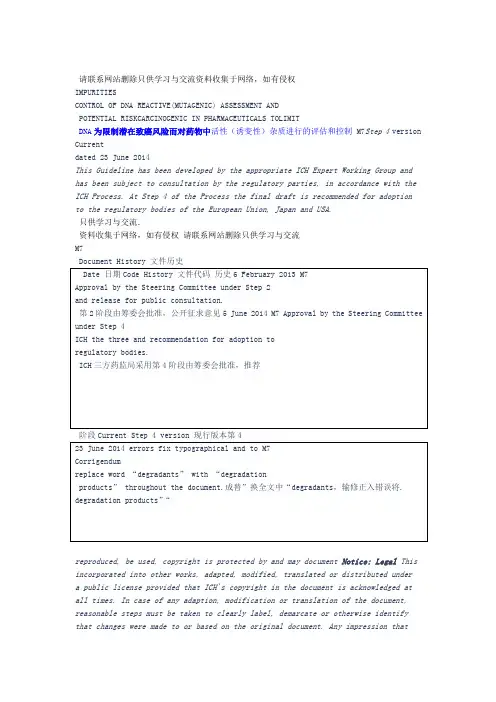
请联系网站删除只供学习与交流资料收集于网络,如有侵权IMPURITIESCONTROL OF DNA REACTIVE(MUTAGENIC) ASSESSMENT ANDPOTENTIAL RISKCARCINOGENIC IN PHARMACEUTICALS TOLIMITDNA为限制潜在致癌风险而对药物中活性(诱变性)杂质进行的评估和控制 M7Step 4 version Currentdated 23 June 2014This Guideline has been developed by the appropriate ICH Expert Working Group and has been subject to consultation by the regulatory parties, in accordance with the ICH Process. At Step 4 of the Process the final draft is recommended for adoption to the regulatory bodies of the European Union, Japan and USA.只供学习与交流.资料收集于网络,如有侵权请联系网站删除只供学习与交流M7Document History 文件历史阶段Current Step 4 version 现行版本第4reproduced, be used, copyright is protected by and may document Notice: Legal This incorporated into other works, adapted, modified, translated or distributed under a public license provided that ICH's copyright in the document is acknowledged at all times. In case of any adaption, modification or translation of the document, reasonable steps must be taken to clearly label, demarcate or otherwise identify that changes were made to or based on the original document. Any impression thatthe adaption, modification or translation of the original document is endorsed or sponsored by the ICH must be avoided.只供学习与交流.请联系网站删除只供学习与交流资料收集于网络,如有侵权The document is provided as is without warranty of any kind. In no event shallthe ICH or the authors of the original document be liable for any claim, damagesor other liability arising from the use of the document.parties. third content supplied by apply above-mentioned The permissions do not to for party, permission third in copyright where for Therefore, documents the vests a reproduction must be obtained from this copyright holder.只供学习与交流.请联系网站删除只供学习与交流资料收集于网络,如有侵权IMPURITIES(MUTAGENIC) OF DNA REACTIVE ASSESSMENT AND CONTROLRISKLIMIT IN PHARMACEUTICALS TO POTENTIALCARCINOGENIC活性(诱变性)杂质进行的评估和控制为限制潜在致癌风险而对药物中DNA ICH Harmonised Tripartite Guideline 三方协调指南ICH Step 4 of the ICH Process at the ICH Steering Committee meeting Having reachedregulatory three on 5 June 2014, this Guideline is recommended for adoption to the parties to ICH资料收集于网络,如有侵权请联系网站删除只供学习与交流只供学习与交流.资料收集于网络,如有侵权请联系网站删除只供学习与交流IMPURITIESDNA REACTIVE (MUTAGENIC) ASSESSMENT AND CONTROL OFRISKPHARMACEUTICALS TO LIMIT POTENTIALCARCINOGENIC IN活性(诱变性)杂质进行的评估和控制为限制潜在致癌风险而对药物中DNA概述1. INTRODUCTIONreagents, chemicals, of reactive drug substances involves the use of The synthesis solvents, catalysts, and other processing aids. As a result of chemical synthesis associated and drug substances degradation, impurities reside in all or subsequent drug products. While ICH Q3A(R2): Impurities in New Drug Substances and Q3B(R2): and for qualification guidance (Ref. 1, 2) provides Impurities in New Drug Products those provided for impurities, limited guidance is control for the majority of the impurities that are DNA reactive. The purpose of this guideline is to provide a categorization, the identification, is applicable to practical framework that potential limit mutagenic these impurities to qualification, and control of carcinogenic risk. This guideline is intended to complement ICH Q3A(R2), Q3B(R2) (Note 1), and ICH M3(R2): Nonclinical Safety Studies for the Conduct of HumanClinical Trials and Marketing Authorizations for Pharmaceuticals (Ref. 3).导致在所有原催化剂和其它工艺助剂,原料药合成牵涉到使用活性化学物质、试剂、溶剂、新原料药中的杂质Q3A(R2)料药及其制剂中会残留有化学合成或其降解产物、杂质。
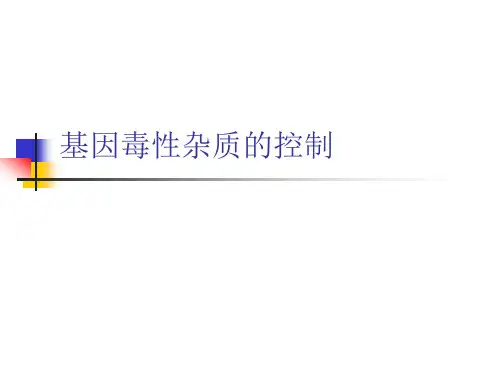
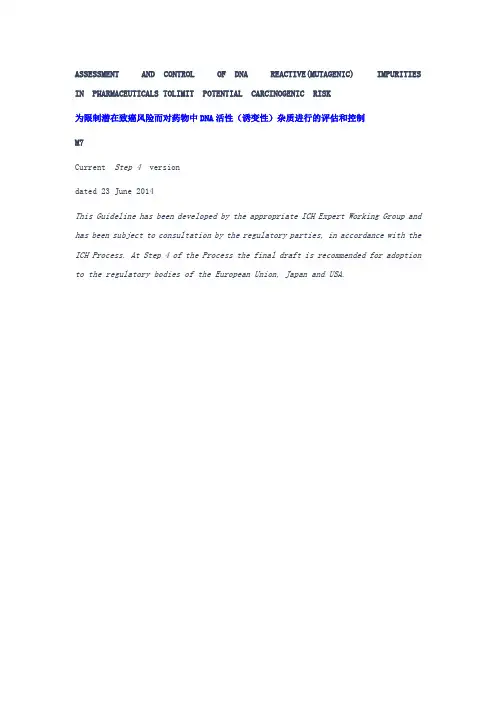
ASSESSMENT AND CONTROL OF DNA REACTIVE(MUTAGENIC) IMPURITIES IN PHARMACEUTICALS TOLIMIT POTENTIAL CARCINOGENIC RISK为限制潜在致癌风险而对药物中DNA活性(诱变性)杂质进行的评估和控制M7Current Step 4 versiondated 23 June 2014This Guideline has been developed by the appropriate ICH Expert Working Group and has been subject to consultation by the regulatory parties, in accordance with the ICH Process. At Step 4 of the Process the final draft is recommended for adoption to the regulatory bodies of the European Union, Japan and USA.M7Document History 文件历史The document is provided "as is" without warranty of any kind. In no event shall the ICH or the authors of the original document be liable for any claim, damages or other liability arising from the use of the document.The above-mentioned permissions do not apply to content supplied by third parties. Therefore, for documents where the copyright vests in a third party, permission for reproduction must be obtained from this copyright holder.ASSESSMENT AND CONTROL OF DNA REACTIVE (MUTAGENIC) IMPURITIES IN PHARMACEUTICALS TO LIMIT POTENTIALCARCINOGENIC RISK为限制潜在致癌风险而对药物中DNA活性(诱变性)杂质进行的评估和控制ICH Harmonised Tripartite GuidelineICH三方协调指南Having reached Step 4 of the ICH Process at the ICH Steering Committee meeting on 5 June 2014, this Guideline is recommended for adoption to the three regulatory parties to ICHASSESSMENT AND CONTROL OF DNA REACTIVE (MUTAGENIC) IMPURITIES IN PHARMACEUTICALS TO LIMIT POTENTIALCARCINOGENIC RISK为限制潜在致癌风险而对药物中DNA活性(诱变性)杂质进行的评估和控制1. INTRODUCTION概述The synthesis of drug substances involves the use of reactive chemicals, reagents, solvents, catalysts, and other processing aids. As a result of chemical synthesis or subsequent degradation, impurities reside in all drug substances and associated drug products. While ICH Q3A(R2): Impurities in New Drug Substances and Q3B(R2): Impurities in New Drug Products (Ref. 1, 2) provides guidance for qualification and control for the majority of the impurities, limited guidance is provided for those impurities that are DNA reactive. The purpose of this guideline is to provide a practical framework that is applicable to the identification, categorization, qualification, and control of these mutagenic impurities to limit potential carcinogenic risk. This guideline is intended to complement ICH Q3A(R2), Q3B(R2) (Note 1), and ICH M3(R2): Nonclinical Safety Studies for the Conduct of Human Clinical Trials and Marketing Authorizations for Pharmaceuticals (Ref. 3).原料药合成牵涉到使用活性化学物质、试剂、溶剂、催化剂和其它工艺助剂,导致在所有原料药及其制剂中会残留有化学合成或其降解产物、杂质。

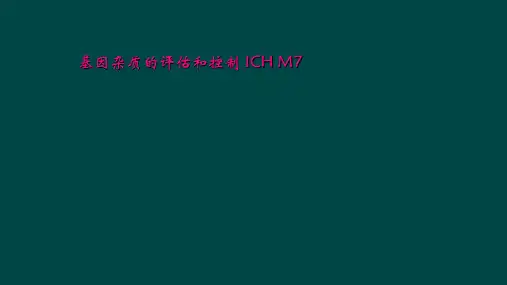
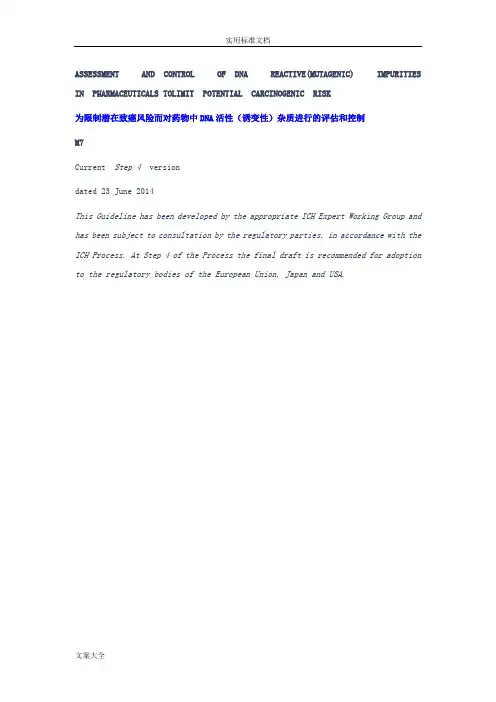
ASSESSMENT AND CONTROL OF DNA REACTIVE(MUTAGENIC) IMPURITIES IN PHARMACEUTICALS TOLIMIT POTENTIAL CARCINOGENIC RISK为限制潜在致癌风险而对药物中DNA活性(诱变性)杂质进行的评估和控制M7Current Step 4 versiondated 23 June 2014This Guideline has been developed by the appropriate ICH Expert Working Group and has been subject to consultation by the regulatory parties, in accordance with the ICH Process. At Step 4 of the Process the final draft is recommended for adoption to the regulatory bodies of the European Union, Japan and USA.M7Document History 文件历史The document is provided "as is" without warranty of any kind. In no event shall the ICH or the authors of the original document be liable for any claim, damages or other liability arising from the use of the document.The above-mentioned permissions do not apply to content supplied by third parties. Therefore, for documents where the copyright vests in a third party, permission for reproduction must be obtained from this copyright holder.ASSESSMENT AND CONTROL OF DNA REACTIVE (MUTAGENIC) IMPURITIES IN PHARMACEUTICALS TO LIMIT POTENTIALCARCINOGENIC RISK为限制潜在致癌风险而对药物中DNA活性(诱变性)杂质进行的评估和控制ICH Harmonised Tripartite GuidelineICH三方协调指南Having reached Step 4 of the ICH Process at the ICH Steering Committee meeting on 5 June 2014, this Guideline is recommended for adoption to the three regulatory parties to ICHASSESSMENT AND CONTROL OF DNA REACTIVE (MUTAGENIC) IMPURITIES IN PHARMACEUTICALS TO LIMIT POTENTIALCARCINOGENIC RISK为限制潜在致癌风险而对药物中DNA活性(诱变性)杂质进行的评估和控制1. INTRODUCTION概述The synthesis of drug substances involves the use of reactive chemicals, reagents, solvents, catalysts, and other processing aids. As a result of chemical synthesis or subsequent degradation, impurities reside in all drug substances and associated drug products. While ICH Q3A(R2): Impurities in New Drug Substances and Q3B(R2): Impurities in New Drug Products (Ref. 1, 2) provides guidance for qualification and control for the majority of the impurities, limited guidance is provided for those impurities that are DNA reactive. The purpose of this guideline is to provide a practical framework that is applicable to the identification, categorization, qualification, and control of these mutagenic impurities to limit potential carcinogenic risk. This guideline is intended to complement ICH Q3A(R2), Q3B(R2) (Note 1), and ICH M3(R2): Nonclinical Safety Studies for the Conduct of Human Clinical Trials and Marketing Authorizations for Pharmaceuticals (Ref. 3).原料药合成牵涉到使用活性化学物质、试剂、溶剂、催化剂和其它工艺助剂,导致在所有原料药及其制剂中会残留有化学合成或其降解产物、杂质。
